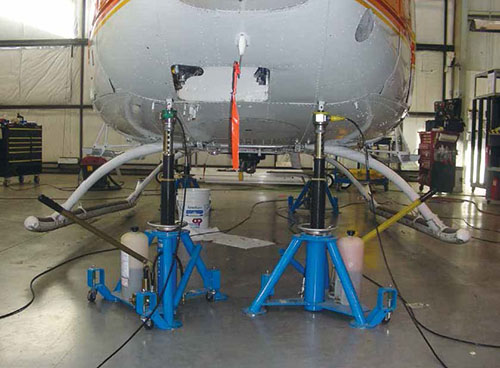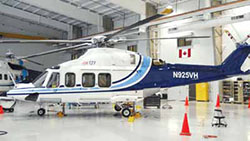
The Ups & Downs of Helicopter Jacking & Lifting


LarryJackson| Contributing Editor
Today, commercial helicopters play a vital role in law enforcement, medical evacuation, off-shore oil support, power line installation and maintenance, VIP transport and a host of other fields. Helicopters come in all sizes and configurations to accomplish these tasks. One size definitely does not fit all. Some helicopters employ landing skids, while others have actual landing gear. If your company performs its own maintenance, depending on what landing configuration your helicopter has, at some point in time your maintenance department will have a need to purchase jacks, jack stands and/or an overhead hoist to service the helicopter.


There are several companies that manufacture and supply jacks. Some helicopter OEMs have specific jack types that can be purchased directly from them. When purchasing jacks, always consult the aircraft maintenance manual for the requirement of the type of jack the helicopter requires for its height and weight range. If operating more than one helicopter model or some from different OEMs, time should be spent analyzing which set of jacks would be best for your fleet.
Hydraulic lifting type jacks are the most common. Tripod type or single cylinder type jacks with multi-lifting stages fit most applications. When looking at purchasing a jack, we should consider not only the type, but the purpose for which it will be used. Not all jacks are created equal. Some have no screw extension capability, some have no wheels for transport across the hangar, and some don’t have the one-inch hole in the top of the jack ram for use with load cell weighing kits. These are things to consider when selecting the type jack being considered for purchase. Of course, money and the company’s budget will always play a role in the decision made.
Proper Jack Use
We really don’t think about a jack, jack stand or overhead hoist until we need to use one. Some things to consider when using jacks are where in the hangar the aircraft will be positioned, what the floor conditions are and how level the floor is. We should always choose a spot that is as level as possible, keeping in mind that hangar floors are usually not level. The floor will always run toward the drain, so we could be jacking a helicopter in a situation that could cause a jack leg to lift or have a non-vertical interface with the jack point.

Ever jack a helicopter and notice when you let it down the jack jumps a little? Or that the jack point is now not aligned to the jack top? Ever see a jack leg lift slightly or have an issue setting the jack to have all its legs firmly on the ground? If so, you have just experienced an out-of-level floor jacking experience. This is true for fixed-wing aircraft as well. An out-of-level condition can cause stability issues and, in severe cases, cause the helicopter to wiggle or become unstable on the jacks.
This problem is compounded when trying to weigh the helicopter on top of jack load cells which can cause false readings on the scale. In severe cases, the load cell can cock and/or be completely ejected from the jack point. This can cause the jack ram and/or cell to contact the bottom skin of the helicopter causing a dent. Worst case scenario, the jack punches through the bottom shell of the helicopter and causes an the need for an expensive repair and/or injures someone.
We should always pick the most level point in the hangar when placing the aircraft on jacks. The aircraft should nose up or down in the direction of the running level to the drains. If need be, a piece of sheet metal can be placed under a jack leg and then level the jack in the vertical. Then conduct the lift with full alignment to the jack point.
Jacks with offset side wheels are not as bad as jacks with “spring position” wheels; however, both types can still have an effect of not being level in the vertical position. Using a digital protractor or bubble level to check the level is a smart way to go. Check the level on the main jack ram, then lift.
Jack Safety
For the most part, jacks and jack stands are pretty safe. There are older units that don’t have some of the safety features of the newer units. Another safety item to be aware of is the load rating on the jack and if the jack has been tested for load and leakage.
Locking collars and/or pins should always be used. If the jack being used doesn’t have a locking collar or pin, be careful that the jack doesn’t leak down over time. I have seen a helicopter jacked up before lunch, then came back after lunch to see that one jack had failed and the helicopter almost fell off the jacks!
The same thing applies for overhead lifts and hoists. Always check to make sure the hoist is load rated and tested. Ensure the lift control being used is guarded and/or the chain is secured so that no loss of the overhead mechanism is possible. Lock out or tag out a hand control for an electric hoist, or pull the circuit breaker to ensure no one inadvertently activates the hoist. You can lock a chain and/or secure a chain hoist to effectively lock it out as well.
Training
I know this is not what you want to hear. Believe me, training is the last thing mechanics want to sit through on a busy day. However, a little time spent by the lead or floor manager can help prevent an accident. A 15-minute training session with the folks on the floor is usually fine. With new mechanics, make sure they know all of the jacks and safety precautions.
Fifteen minutes of time. If you don’t know where to start, just read this article to the guys and briefly discuss the jack types, stands and hoists in the shop with your personnel. Discuss the best location to conduct normal maintenance for long-term storage and use of locks and or lock-out procedures. If weighing a helicopter, always review the level and make sure the mechanics know to level the jacks in position and not jack over drains or other floor areas that will compound a poor lift.
Not Rocket Science
No, it’s not rocket science — but every year a helicopter will get dropped, slip off a jack and/or eject a load cell while being weighed. I hear of at least two or three events every year where a jack collapsed, leaked down, and/or a hoist chain or hook failed. Check your equipment. Know your equipment and have a jack training session documented in everyone’s training records.
 Larry Jackson is an AP/IA and has been in aircraft/helicopter maintenance for more than 30 years. His company, Jackson Aircraft Weighing Service, sells and services scales for the helicopter industry, as well as provides information on jacking applications for weighing aircraft.
Larry Jackson is an AP/IA and has been in aircraft/helicopter maintenance for more than 30 years. His company, Jackson Aircraft Weighing Service, sells and services scales for the helicopter industry, as well as provides information on jacking applications for weighing aircraft.
